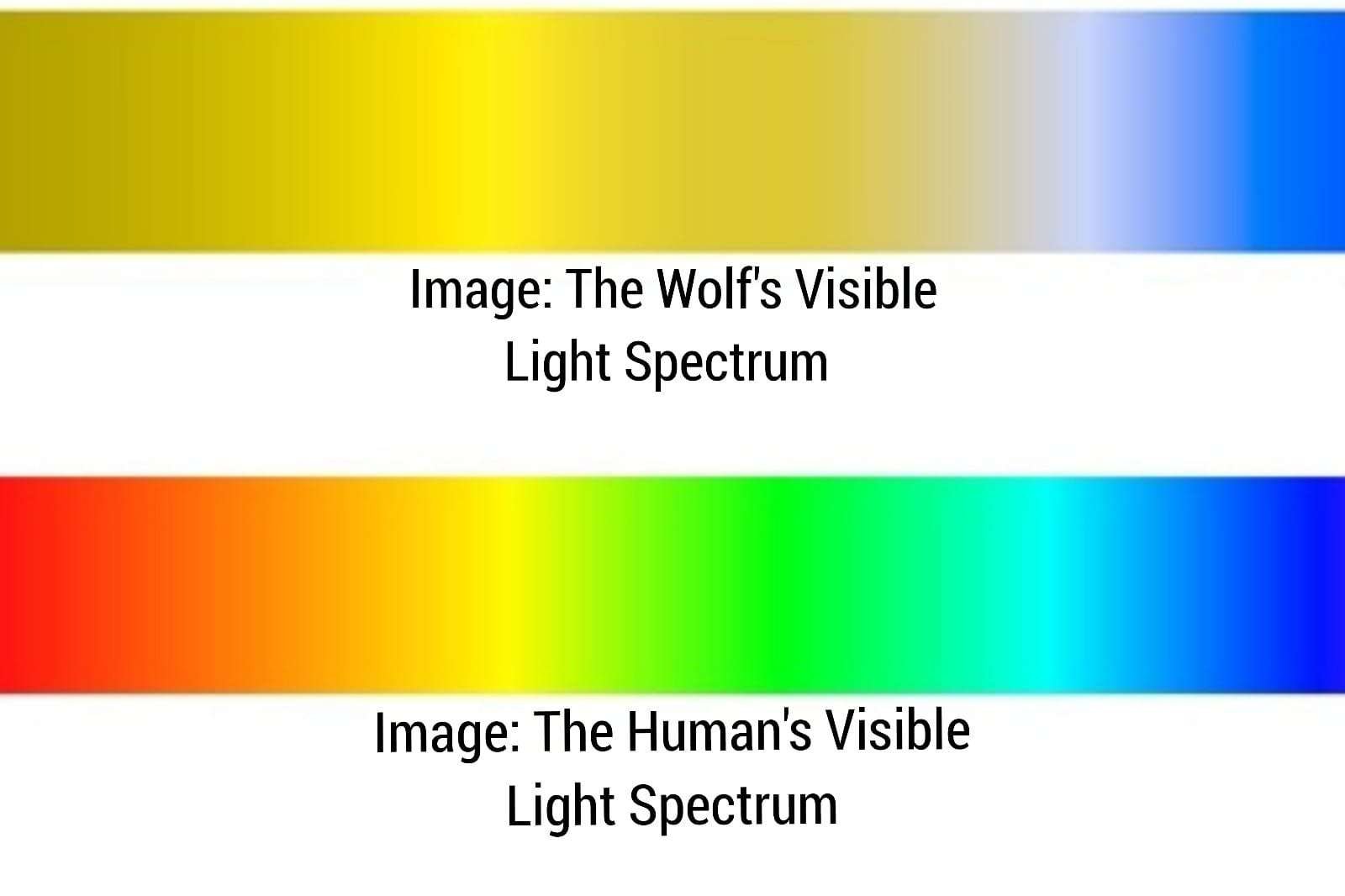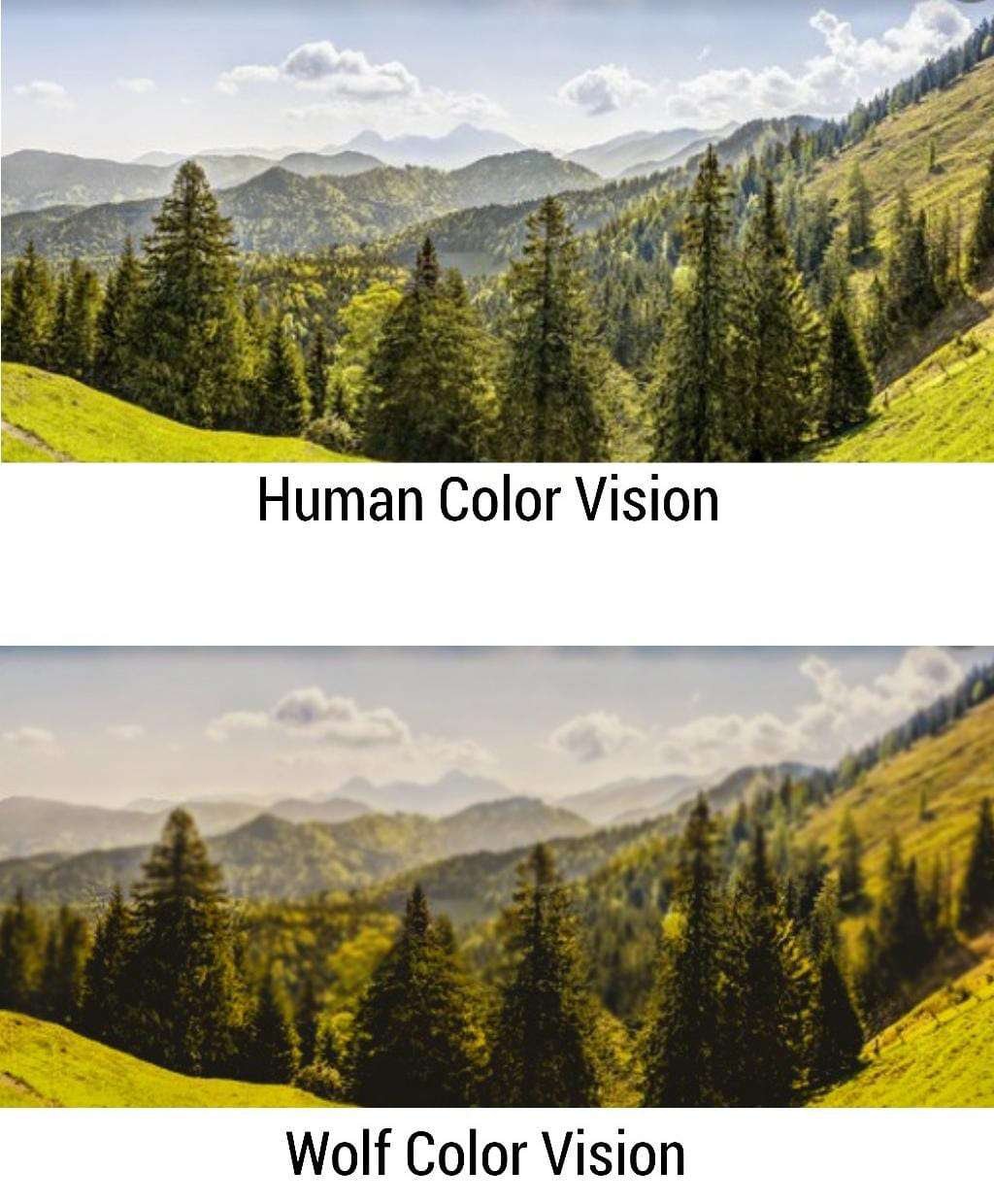Wolves are the most prominent living member of the Canidae family, with more than thirty subspecies natives across Eurasia and North America.
They are wild animals and considered to be the deadliest. So, are you curious to learn how wolves see the world or what colors do they see? If yes, then this post is best for you.
The answer to the question, “What colors do wolves see,” is: Wolves can only see different color shades of blue and yellow. Their eyes are sensitive to only small (blue) and medium (yellow) wavelengths of color variations. Wolves have dichromatic vision. Therefore, they perceive the world in different hues.
Wolves are primarily dependent on the senses of hearing and smell.
However, it doesn’t mean that they have weak eyesight. In terms of clarity, they can glimpse it as similar to us. Later in this post, we have explained the wolves’ vision in detail. So, let’s begin.
What colors do Wolves see?
Wolves are dichromats and can see the different color variations between blue and yellow. The receptors in their eyes are not sensitive to large wavelength colors like orange and red.
It doesn’t represent that they cannot perceive the red color. They can, but due to the absence of large wavelength cones, wolves sense the red color variations in gray shades.

According to the research, it is believed thatwolves are partially colorblind and have only blue and red photoreceptors in their eyes.
It implies they can smoothly distinguish the difference between blue and red or red and yellow but cannot discern yellow from green or orange from red.
Below we have attached an image of wolves’ color vision for better understanding.
As justified by the picture, the visible spectrum of wolves comprises only yellow, blue, and gray shades, whereas humans are trichromats and recognize millions of color variations.
However, wolves have a precise vision and have the ability to glimpse white and black at night as compared to humans. Also, they do not solely rely on their sense for survival; they have the keenest smell and hearing senses.
Are Wolves color blind?
No, wolves are not completely colorblind. They have only red color blindness. Wolves can see colors but cannot differentiate millions of color shades as similar to humans.
They witness the world with pale colors, mostly with the shades of yellow, blue, and gray.
Also, wolves have strong receptors for gray, and due to the absence of the large wavelength cone, they recognize bright colors like pink, orange, red, green, neon, etc., in the shades of gray or pale-yellow.
There are two types of photoreceptors in the retina: cones and rods. Cones are responsible for color vision, and rods help to sense the light.
In the cones, humans have the upper hand because we are trichromatic and have all three small, medium, and large wavelength cones that help us to distinguish millions of color shades.
But wolves are dichromats and can distinguish colors up to a certain wavelength.
However, let’s take the reference of rods. Wolves have the superiority because they have more rods in their eyes that are sensitive to light and assist them in glimpsing much better in low light conditions.
Can Wolves see color?
Wolves see blue, yellow, and brownish-gray color shades. Their color receptors are not as advanced as humans. But they have a keen vision that qualifies them to witness in the dark better than us.
Also, wolves and dogs share similar eyesight allowing them to sense similar colors. They have paler vision with sharpness like old photos with faded colors.

The reason behind this is the absence of the third cone in their eyes. In comparison to humans, wolves only have two types of cones in their eyes, granting them to sense less color variation than humans.
Conversely, they have a large ratio of rods recognizing them to see much better in the dark, even with the slightest light, as compared to us.
Also, in terms of smell and sense, wolves are far better than us. Therefore, it will be much better if you avoid them, especially at night, because they can see, smell and hear you.
How do Wolves see the world?
Wolves see the world in blue, yellowish, and brownish-gray shades with a clear vision in daylight.
They detect the world slightly better than a deer but not as much as a bear. At night, wolves comprehend much better than other nocturnal predators with the help of tapetum lucidum.
And in the full moon night, they perceive the environment as bright as day with white and black shades.
Here is the pictorial representation of how do wolves see the world. As represented by the picture, wolves recognize brown cows and green grass as the same dull-yellowish shade.
Can Wolves see in the Dark?
Wolves can see in the dark better than humans. It’s true that wolves’ eyes have a higher number of gray tone sensitive cells that entitle them to distinguish the different shapes at night.
They have evolved to hunt mostly at dawn and dusk. That’s why their eyes are most sensitive at that time.

Wolves also have tapetum lucidum, a reflective layer lining the back of their eyeball.
With the help of tapetum lucidum, their eyes can perceive even a dim light from the surrounding, empowering them to discern brightly in the dark.
However, wolves are not relying on their eyesight at night. Their other senses, like whiskers (to feel the objects when touched) and smell, are also some of the best among the nocturnal predators.
Therefore, it is nearly impossible to outrun a pack of wolves in the dark.
How far can Wolves see in the Dark?
Wolves can clearly see up to somewhere between 20-25 meters. Unlike humans, wolves cannot comprehend that well at far distances.
Their vision gets blurred. However, to overcome this inferiority, they have an incredible smell that allows them to smell prey up to 1.5 miles away.
Not only this, wolves are twenty times more sensitive than humans in terms to distance motion.
Wolf Vision vs. Human Vision
| Wolf Vision | Human Vision |
| Are dichromats | Are trichromats |
| Can see the world mostly in blue, gray and yellowish shades | Can see the world in millions of color shades. |
| Have better night vision | Does not have night vision |
| Can see clearly up to 75 feet | See up to 3 miles (15840 feet) |
Wolves have a unique visual system that is adapted to their nocturnal lifestyle and hunting habits. While their color vision is not as advanced as that of humans, wolves are still able to distinguish between shades of blue and yellow.
Their night vision, on the other hand, is highly specialized and allows them to see in low-light conditions that would be difficult or impossible for humans.
Wolves have several adaptations that enhance their night vision, including a tapetum lucidum and a high density of rod cells in their retinas.
By understanding how wolves see and navigate their environment, researchers can gain valuable insights into their behavior and ecology, which can ultimately aid in their conservation and management.
Here, we conclude our article on “What colors do Wolves see,” along with other minor queries that will help you gain knowledge. Also, this article is only for knowledge-sharing purposes. We will be back with another post. Till then, stay tuned and stay healthy.
Frequently Asked Questions
Q1. Can wolves smell fear?
Ans. Wolves can sense if the animal is fear or not with the use of other animal senses and techniques.
Q2. Are Arctic wolves dangerous?
Ans. Usually, Arctic wolves are not dangerous. But if someone is trespassing their territory, then they feel threatened, and for the safety of their family, they become aggressive.
Q3. Are Arctic wolves friendly?
Ans. It depends. Sometimes, Arctic wolves approach humans in a friendly manner because we are not their natural prey. However, they feel threatened, then they probably attack humans.
Q4. Do wolves have good eyesight?
Ans. Yes, wolves have excellent eyesight, similar to humans. Although they perceive fewer colors but they have a clear vision.
Symbols-
1 meter= 3.28 feet
References
Wolf senses (specifically, sight) by Live Journal
FAQ: Wolves by SAINT FRANCIS WOLF SANCTUARY, FaunaFacts
Also Read:

Meet Abhidept (nickname Monty), the visionary founder of How It See, being an engineering student, he’s fueled by an insatiable curiosity about the world around him. He is captivated by an eclectic correlation between animal groups, science, and nature, and this fascination drives his quest for understanding.
After completing his degree, he’s set on a mission to delve deep into the realm of nature, accumulating knowledge to share with you through his writing. In the meantime, he loves to watch anime and read anime.
